Young farmers Katie Doyle Smith and Paul Swegel of Pork Hill Farm supply vegetables to Carroll County, New Hampshire, where the growing season is short but the demand for local, organic produce continues to grow. In order to address this challenge, Paul and Katie applied for the Environmental Quality Incentives Program (EQIP)’s Seasonal High Tunnel Initiative through the U.S. Department of Agriculture’s (USDA) Natural Resources Conservation Service (NRCS).
The program provided cost-share funding for a high tunnel, where Katie and Paul produced greens, such as kale and bok choy, well into February for a multi-farm Community Supported Agriculture (CSA). The high tunnel enabled them to tap into markets that would have otherwise been out of reach.
“It is amazing that 300 tomato plants in the high tunnel can produce the same yield as the 1,200 tomato plants growing outside,” Katie explained. “Growing in the high tunnel takes up less space by growing vertically, helps regulate water usage, and we can produce more marketable tomatoes for essential wholesale markets.”
Program Overview
The EQIP Seasonal High Tunnel Initiative provides cost-share funding and technical assistance to farmers who want to extend the growing seasons on their farms by using high tunnels.
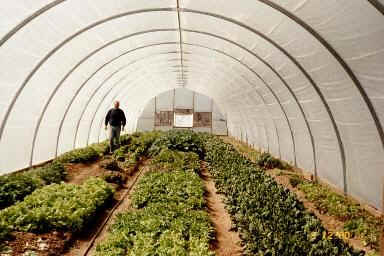
High tunnels (also known as hoop houses) are structures that modify the growing environment through the construction of hoops covered with plastic that are placed over the growing area. Unlike some greenhouses, high tunnels require no energy as they rely on natural sunlight to modify the inside climate, creating favorable conditions for producing vegetables and specialty crops.
Program History
The seasonal high tunnel initiative began as a three- year pilot program in 2009, establishing high tunnels as an interim conservation practice standard. The pilot program was designed to help NRCS assess environmental benefits that may result from the use of the tunnels. After three years of continued growth and interest in the program, the seasonal high tunnel switched over to become an established conservation practice standard (#798 in the NRCS numbering system) in fiscal year (FY) 2014.
As the program transitioned to a conservation practice standard for FY 2014, several other changes were also put into effect for high tunnel signups:
- Previously the pilot program set a maximum size of 2,178 square feet (5 percent of an acre) of high tunnel that could be funded through NRCS, based on a payment per foot rate. Many producers found this size limit to be restrictive, and beginning in FY 2014, the cap has been lifted. However, individual states are able to establish state specific limits, either by acreage or by funding levels, in order to ensure that high tunnels remain reasonably sized and can be distributed equitably throughout the country. Therefore, farmers should check with their state or local NRCS office for further details.
- Additionally, EQIP funding for the Seasonal High Tunnel Initial will be coming out of states’ general funds, rather than a specific allocation going to each state that was then rolled over if funds aren’t used. High tunnels will be available to farmers in all states, but states now have the option of whether or not to make it a special initiative with its own separate pool of funds. This change means that it will be all the more important for state NRCS staff to conduct outreach to ensure continued participation in the Seasonal High Tunnel Initiative.
Increased Interest in Season Extension
Launched in 2009, the EQIP Seasonal High Tunnel Initiative has provided assistance for over 13,000 high tunnels on farms in all 50 states as well as Puerto Rico and the Pacific Basin. The program has so far obligated over $61 million in cost shares to support the construction of high tunnels.
Between 2010 and 2013 the number of high tunnel contracts has increased, with the most significant jump between FY 2011 and FY 2012, increasing by more than 70 percent. Data is not yet available for FY 2014, but NRCS and the National Sustainable Agriculture (NSAC) hope that program participation rates continue to grow.
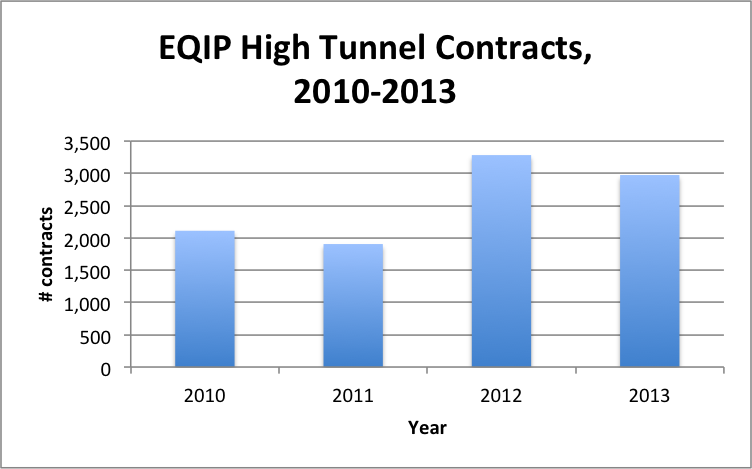
As to be expected, high tunnels are most popular in states with relatively shorter growing seasons, such as Alaska, Michigan, Wisconsin, and Minnesota. Some states, such as Kentucky, Indiana, and Maryland, did not have any high tunnel contracts during the program’s first two years, but increased significantly starting in fiscal year 2011. These dramatic shifts likely illustrates the critical role that state NRCS offices play in promoting the program, which will be all the more important with the shift in how states allocate funds.

High Tunnels Serve the Historically Underserved
High tunnel EQIP payments are made to producers based on a set rate per foot of high tunnel constructed. Historically underserved producers, including beginning, socially disadvantaged, and limited resource farmers and ranchers, are eligible for a higher payment rate within all the statewide and county level programs under EQIP.
Promoting the high tunnel program to these groups makes sense in order to ensure that groups who face the greatest barriers to accessing capital and farmland can also participate and benefit from season extension and related conservation practices. Significantly extending the growing season enables these farmers to tap into critical markets at times when they would otherwise be unable to supply any produce.
Thus far the participation rates from the program data show that the demand from historically underserved populations is undoubtedly strong. In comparing participation rates for historically underserved and all other producers between 2010 and 2013, this gap has grown increasingly larger over time.
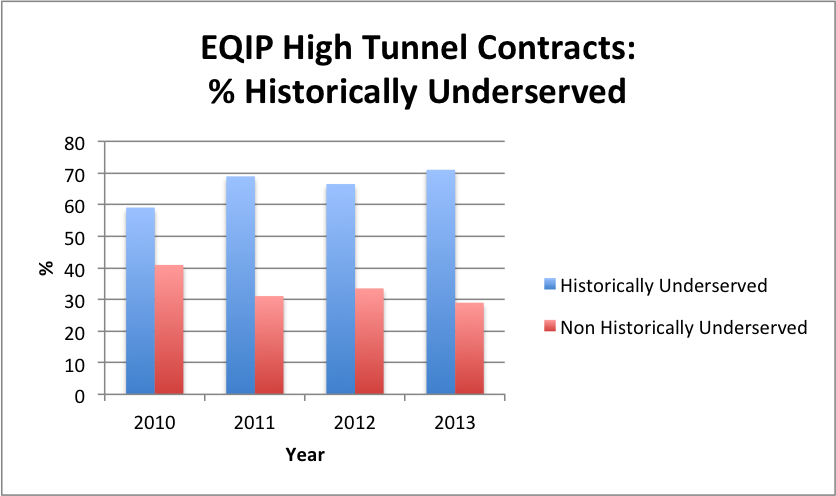
Of the three groups of historically underserved farmers who use the high tunnel program, in particular beginning farmers have shown especially high levels participation. Between 2010 and 2013, beginning farmer high tunnel contracts increased from 39 to 51 percent of total program contracts.
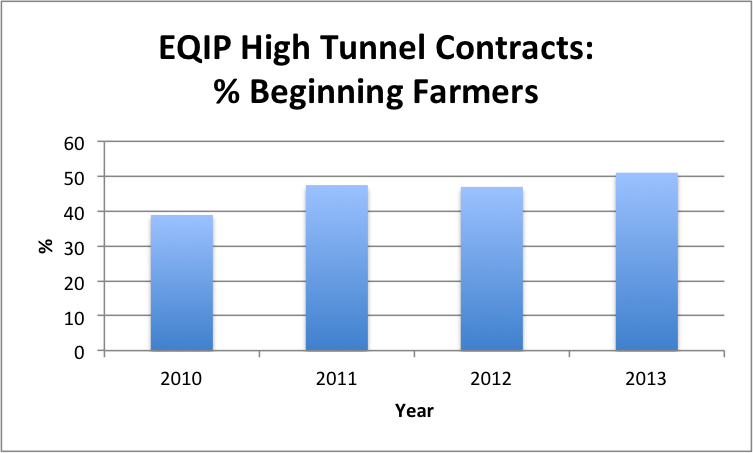
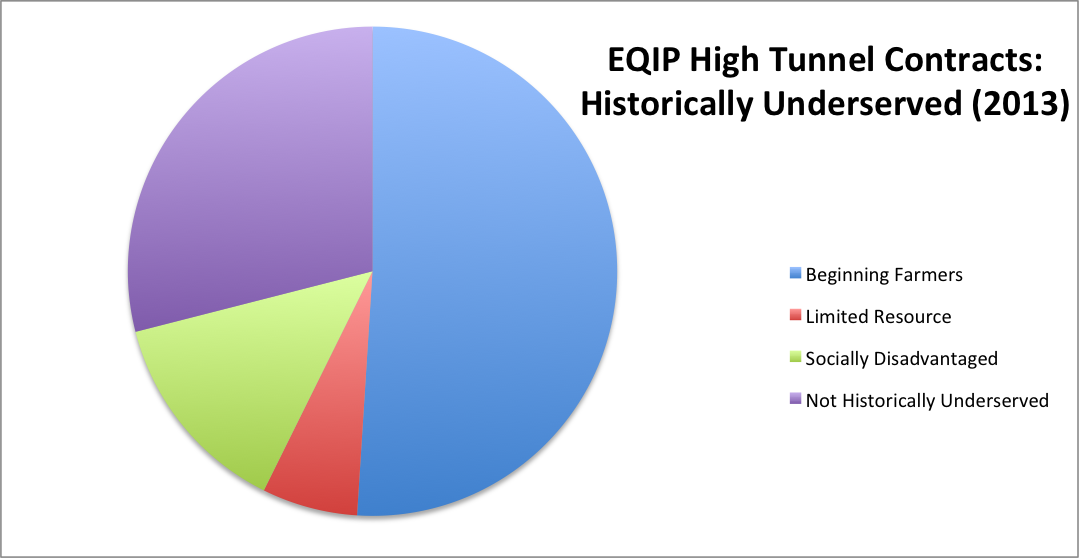
Furthermore, in 2013 all historically underserved producers accounted for over 70 percent of all EQIP seasonal high tunnel contract holders. This rate is significantly higher than national participation rates for EQIP programs at large, as only 26 percent of all EQIP contracts went to historically underserved producers, of which 16 percent went to beginning farmers (compared to 51 percent of high tunnel contracts currently supporting beginning farmers).
Season Extenders are Conservationists, too!
NRCS initially established high tunnels as an interim standard in order to assess environmental benefits that may result from the use of the tunnels, as farmers take steps to control runoff, save water, limit pesticide use, and engage in other conservation measures. The controlled environment of the high tunnel has implications for water conservation, pest management, and energy usage. On top of these benefits, data shows that many farmers with EQIP high tunnel contracts are also implementing other conservation practices on their land. High tunnel contract holders are also implementing more than 90 other EQIP conservation practices, such as nutrient management, cover crops, and integrated pest management.
Of all high tunnel contract holders in the program’s first four years, 17 percent simultaneously held a contract for nutrient management, which provides a roadmap to help producers apply nutrient sources in the right amount and at the right time to obtain the maximum agricultural and environmental benefits. Nutrient requirements are based on NRCS- approved nitrogen and phosphorus risk assessments.
High tunnel users also used cover crops on their land, with 13 percent of contract holders also implementing the cover crop conservation practice in order to prevent erosion, improve soil health, provide nutrients, suppress weeds, increase soil water content, and break pest cycles.
Additionally, 10 percent of high tunnel contract holders signed up for the Integrated Pest Management (IMP) conservation standard, which is an ecosystem-based strategy, enabling farmers to identify and reduce risk from pests using pest-management related strategies. IPM provides producers with an alternative to intensive, conventional pesticide use.
Furthermore, additional practices as also available to producers, as determined by each state, to help ensure that the resource concerns are addressed when implementing and managing the Seasonal High Tunnel. Supporting practices may include critical area planning, diversion, grassed waterway, irrigation reservoir, micro irrigation, subsurface drain, and underground outlet.
Continued Demand
In looking to further expand their CSA and tap into additional markets like local restaurants, Katie and Paul hope to add a second high tunnel to Pork Hill Farm. The added season extension is absolutely critical, Katie explained, as they continue to establish a reliable market and integrate a variety of conservation practices into their farming.
The National Sustainable Agriculture Coalition (NSAC) will continue to work to ensure that funding for EQIP and other farm bill conservation programs remains available for producers seeking to extend the growing season while integrating sustainable conservation practices onto their operations.
How to Apply
States may establish their own application periods in which to consider eligible applications for funding. Farmers interested in constructing a seasonal high tunnel through EQIP should contact their local NRCS office.

